Fallow Deer (Dama dama) Population and Harvest Changes in Europe since the Early 1980s
Abstract
1. Introduction
2. Materials and Methods
2.1. Data Collection
2.2. Data Analysis
3. Results
3.1. Period from 1984–2000s
3.2. Period from 1984–2010s
3.3. Period from 1984–2020s
3.4. Period from 2000s–2010s
3.5. Period from 2000s–2020s
3.6. Period from 2010s–2020s
4. Discussion
Author Contributions
Funding
Institutional Review Board Statement
Informed Consent Statement
Data Availability Statement
Acknowledgments
Conflicts of Interest
Appendix A
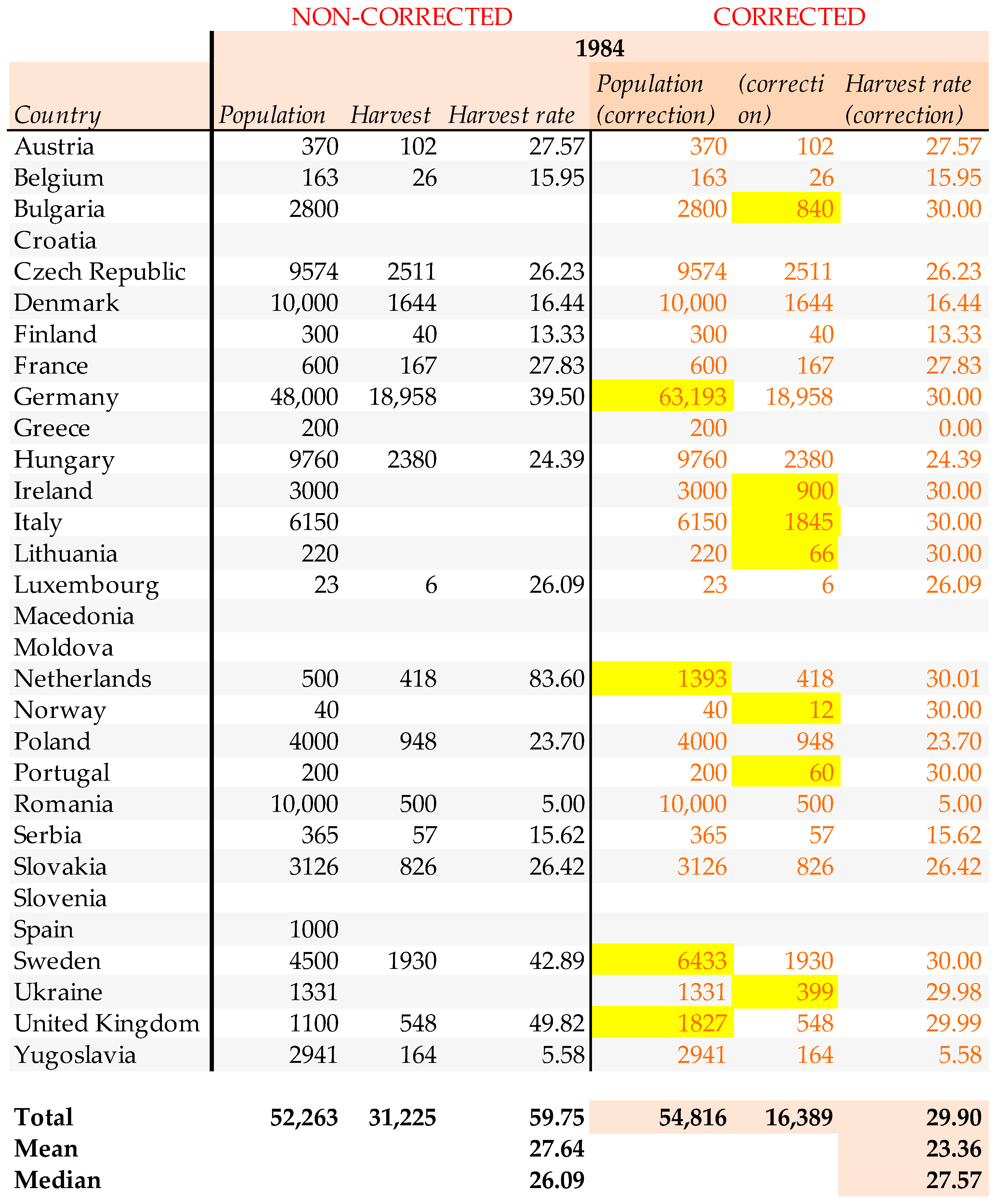
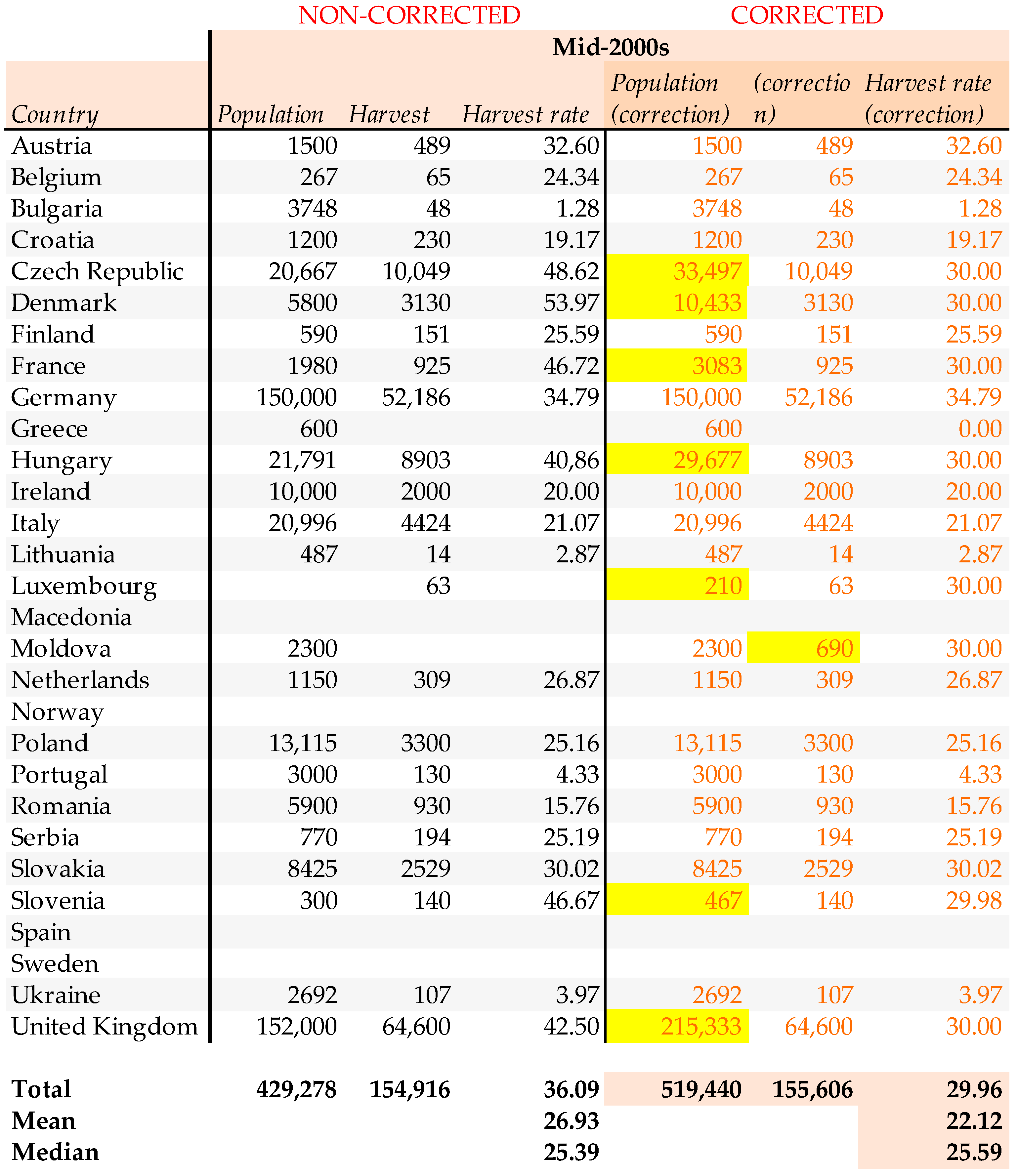
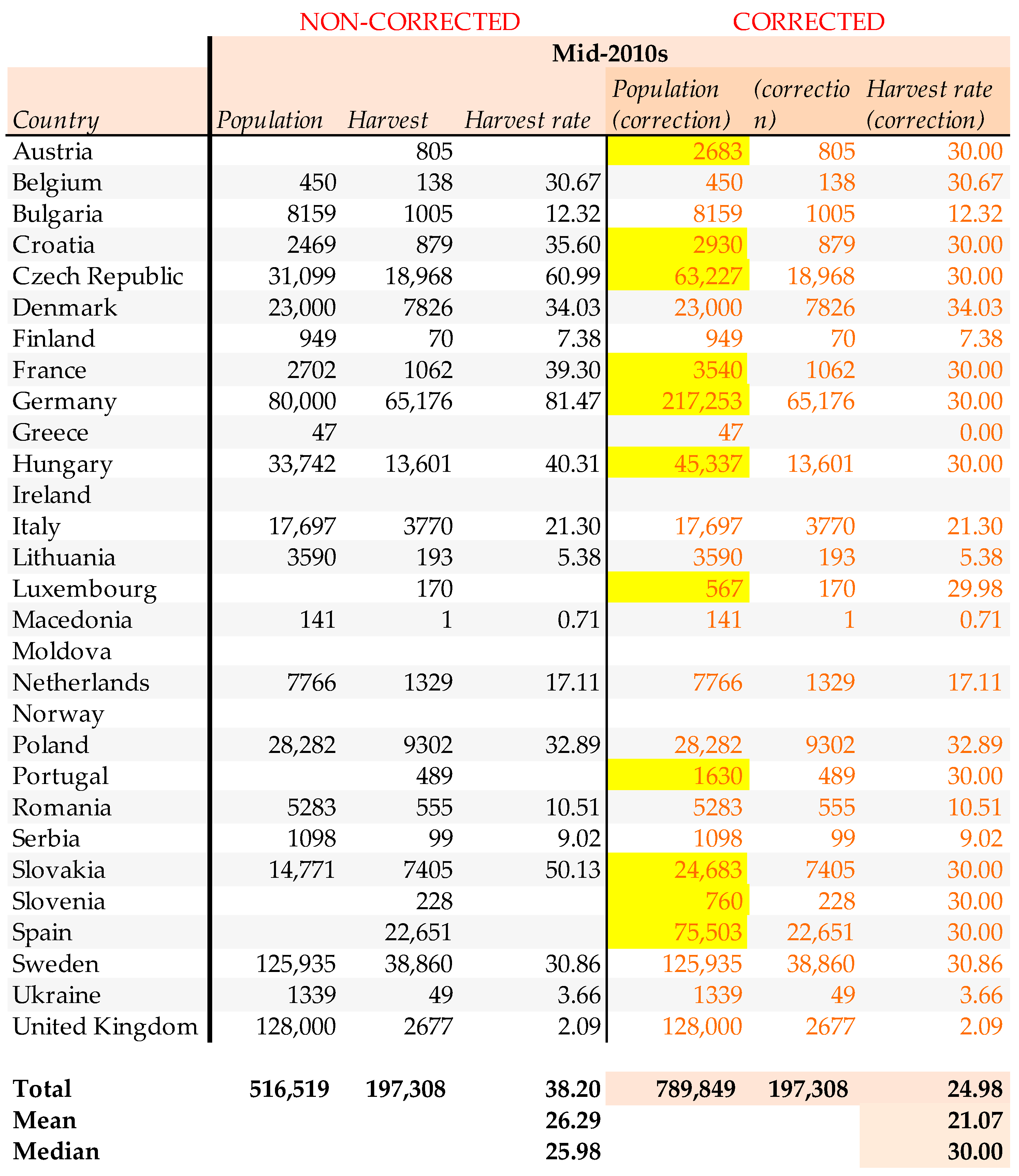

References
- Chapman, N.G.; Chapman, D.I. The distribution of fallow deer: A worldwide review. Mamm. Rev. 1980, 10, 61–138. [Google Scholar] [CrossRef]
- Ludwig, A.; Vernesi, C.; Lieckfeldt, D.; Lattenkamp, E.Z.; Wiethölter, A.; Lutz, W. Origins and patterns of genetic diversity of German fallow deer as inferred by mitochondrial DNA. Eur. J. Wildl. Res. 2012, 58, 495–501. [Google Scholar] [CrossRef]
- De Marinis, A.M.; Chirichella, R.; Apollonio, M. Common Fallow Deer Dama dama (Linnaeus, 1758). In Handbook of the Mammals of Europe; Hackländer, K., Zachos, F., Eds.; Springer Nature: Cham, Switzerland, 2022; pp. 1–41. [Google Scholar]
- Masseti, M. The postglacial diffusion of the genus Dama Frisch, 1775, in the Mediterranean region. Ric. Biol. Selvag. 1996, 25, 7–29. [Google Scholar]
- Chakanya, C.; Muchenje, V.; Hoffman, L.C. The fallow deer (Dama spp.); endangered or not? Zool. Gart. 2016, 85, 160–172. [Google Scholar] [CrossRef]
- Relva, M.A.; Nunez, M.A.; Simberloff, D. Introduced deer reduce native plant cover and facilitate invasion of non-native tree species: Evidence for invasional meltdown. Biol. Invasions 2010, 12, 303–311. [Google Scholar] [CrossRef]
- Martin, T.G.; Arcese, P.; Scheeder, N. Browsing down our natural heritage: Deer impacts on vegetation structure and songbird populations across an island archipelago. Biol. Cons. 2011, 144, 459–469. [Google Scholar] [CrossRef]
- Spear, D.; Chown, S. Non-indigenous ungulates as a threat to biodiversity. J. Zool. 2009, 279, 1–17. [Google Scholar] [CrossRef]
- Khoshbakht, R.; Tabatabaei, M.; Aski, H.S.; Shayegh, H. Distribution of Salmonella, Arcobacter, and thermophilic Campylobacter spp. among Persian fallow deer (Dama mesopotamica) populationin Dasht-e-Arzhan wildlife refuge, southern Iran. Comp. Clin. Pathol. 2015, 24, 777–781. [Google Scholar] [CrossRef]
- Genovesi, P.; Bacher, S.; Kobelt, M.; Pascal, M.; Scalera, R. Alien Mammals of Europe. In Handbook of Alien Species in Europe; Invading Nature—Springer Series in Invasion Ecology; Springer: Dordrecht, The Netherlands, 2009; Volume 3, pp. 119–128. [Google Scholar]
- Esattore, B.; Saggiomo, L.; Sensi, M.; Francia, V.; Cherin, M. Tell me what you eat and I’ll tell you…where you live: An updated review of the worldwide distribution and foraging ecology of the fallow deer (Dama dama). Mamm. Biol. 2022, 102, 321–338. [Google Scholar] [CrossRef]
- Putman, R.; Apollonio, M.; Andersen, R. Ungulate Management in Europe: Problems and Practices; Cambridge University Press: New York, NY, USA, 2011; pp. 1–395. [Google Scholar]
- Ahl, M.; Elmhagen, B.; Bergqvist, G. Survey of methods for harvest reporting of game species in Europe. Viltforum 2021, 2020/5, 1–49. [Google Scholar]
- Burbaitė, L.; Csányi, S. Roe deer population and harvest changes in Europe. Estonian J. Ecol. 2009, 58, 169–180. [Google Scholar] [CrossRef]
- Burbaitė, L.; Csányi, S. Red deer population and harvest changes in Europe. Acta Zool. Litu. 2010, 20, 179–188. [Google Scholar] [CrossRef]
- Gill, R. Monitoring the Status of European and North American Cervids; GEMS Information Series; Global Environment Monitoring System; United Nations Environment Programme: Nairobi, Kenya, 1990; No. 8; p. 277. [Google Scholar]
- CIC (International Council for Game and Wildlife Conservation). Le Daim, The Fallow Deer, Der Damwild (Dama dama L.). In Proceedings of the Symposium, Budapest, Hungary, 16–17 January 1984. [Google Scholar]
- National Statistical Institute. Statistical Reference Book 2021; National Statistical Institute: Sofia, Bulgaria, 2021.
- National Statistical Institute. Statistical Reference Book 2017; National Statistical Institute: Sofia, Bulgaria, 2017.
- Stoyanov, N.; Stoyanova, M. Geneva Timber and Forest Discussion Paper 38—Forest and Forest Products Country Profile: Republic of Bulgaria; United Nations: Geneva, Switzerland, 2005. [Google Scholar]
- Vildtbestande og Jagttider i Danmark: Det Biologiske Grundlag for Jagttidsrevisionen 2018; Videnskabelig Rapport fra DCE—Nationalt Center for Miljø og Energi. Nr. 195; Aarhus Universitet: Aarhus, Denmark, 2016.
- Danmarks Jaegerforbund. Hjortevildt Oversigten 2020. Natur/vildtforvaltning, Jaeger 9/2020. Available online: https://www.jaegerforbundet.dk/media/15834/hjortevildtoversigten_2020.pdf (accessed on 20 August 2022).
- ONCFS (Office National de la Chasse et de la Faune Sauvage). Grand Ongulés—Tableaux de Chasse Nationaux. Available online: http://www.oncfs.gouv.fr/Grands-ongules-Tableaux-de-chasse-ru248/-Grands-ongules-Tableaux-de-chasse-nationaux-news467 (accessed on 9 August 2017).
- Saint-Andrieux, C. Prélèvements Ongulés Sauvages Saison 2020–2021; Réseau Ongulés Sauvages: La Petite-Pierre, France, 2021. [Google Scholar]
- Bayerischer Jagdverband e.V. Damwild. Available online: https://www.jagd-bayern.de/damwild.html (accessed on 15 August 2017).
- Bestand des Damwildes in Deutschland; Drucksache 20/532; Deutscher Bundestag: Berlin, Germany, 2022.
- Mattila, M.; Hadjigeorgiou, I. Conservation and management of fallow deer (Dama dama dama L.) on Lemnos Island, Greece. Turk. J. Vet. Anim. Sci. 2015, 39, 560–567. [Google Scholar] [CrossRef]
- Vadgazdálkodási Adattár—2005/2006; Vadászati Év; Országos Vadgazdálkodási Adattár: Gödöllő, Hungary, 2006; 63p.
- Csányi, S.; Kovács, I.; Csókás, A.; Putz, K.; Schally, G. Vadgazdálkodási Adattár—2015/2016; Vadászati Év; Országos Vadgazdálkodási Adattár: Gödöllő, Hungary, 2016; 48p. [Google Scholar]
- Csányi, S.; Márton, M.; Major, F.C.; Schally, G. Vadgazdálkodási Adattár—2020/2021; Vadászati Év; Országos Vadgazdálkodási Adattár: Gödöllő, Hungary, 2021; 70p. [Google Scholar]
- Carnevali, L.; Pedrotti, L.; Riga, F.; Toso, S. Banca Dati Ungulati: Status, Distribuzione, Consistenza, Gestione e Prelievo Venatorio Delle Popolazioni di Ungulati in Italia; Rapporto INFS 2001–2005; ISPRA: Rome, Italy, 2009. [Google Scholar]
- Mazzella, D. (Ed.) Linee Guida per la Gestione Degli Ungulati. Manuali e Linee Guida 91/2013; ISPRA (L’istituto Superiore per la Protezione e la Ricerca Ambientale): Rome, Italy, 2013. [Google Scholar]
- Lithuanian State Forest Service. Lithuanian Statistical Yearbook of Forestry 2006; Ministry of Environment: Vilnius, Lithuania, 2007.
- Lithuanian State Forest Service. Lithuanian Statistical Yearbook of Forestry 2016; Ministry of Environment: Vilnius, Lithuania, 2017.
- Lithuanian State Forest Service. Lithuanian Statistical Yearbook of Forestry 2020; Ministry of Environment: Vilnius, Lithuania, 2021.
- Spek, G.J. Jaarrapportage Grofwild 2016–2017; Nieuwsbrief nr 43; Vereniging Wildbeheer Veluwe: Vaassen, The Netherlands, 2017. [Google Scholar]
- Faunabeheereenheid. Available online: https://www.faunabeheereenheid.nl (accessed on 10 March 2022).
- Central Statistical Office, Agriculture Department; Domaszewicz, B. Forestry 2016; Central Statistical Office: Warsaw, Poland, 2016. [Google Scholar]
- Rozkrut, D. (Ed.) Statistical Yearbook of Forestry 2021; Statistics Poland: Warsaw, Poland, 2021.
- Fondul Cinegetic 2008; Nr. 146 din 31 iulie 2009; Comunicat de Presă; National Institute of Statistics: Bucharest, Romania, 2009.
- Kovačić, M. (Ed.) Forestry in the Republic of Serbia 2020; Bulletin; Statistical Office of the Republic of Serbia: Belgrade, Serbia, 2021.
- Poročilo Zavoda za Gozdove Slovenije o Gozdovih za Leto 2015; Zavod za Gozdove Slovenije: Ljubljana, Slovenia, 2016.
- Poročilo Zavoda za Gozdove Slovenije o Gozdovih za Leto 2020; Zavod za Gozdove Slovenije: Ljubljana, Slovenia, 2021.
- Anuario de Estadística Forestal 2005; Ministerio para la Transición Ecológica y el Reto Demográfico: Madrid, Spain. Available online: https://www.miteco.gob.es/es/biodiversidad/estadisticas/forestal_anuario_2005.aspx (accessed on 10 August 2022).
- Anuario de Estadística Forestal 2014–2015; Ministerio para la Transición Ecológica y el Reto Demográfico: Madrid, Spain, 2018.
- Anuario de Estadística Forestal 2019; Ministerio para la Transición Ecológica y el Reto Demográfico: Madrid, Spain, 2021.
- Danell, K.; Bergström, R. Vilt, Människa, Samhälle; Liber: Stockholm, Sweden, 2010; 320p. [Google Scholar]
- Verner, I. (Ed.) Statistical Yearbook of Ukraine 2005; State Statistics Service of Ukraine: Kyic, Ukraine, 2006.
- Verner, I. (Ed.) Statistical Yearbook of Ukraine 2015; State Statistics Service of Ukraine: Kyic, Ukraine, 2016.
- Verner, I. (Ed.) Statistical Yearbook of Ukraine 2020; State Statistics Service of Ukraine: Kyic, Ukraine, 2021.
- NatureScot. Available online: https://www.nature.scot/snh-deer-census-results (accessed on 4 March 2022).
- Mathews, F.; Harrower, C. IUCN—Compliant Red List for Britain’s Terrestrial Mammals. Assessment by the Mammal Society under contract to Natural England, Natural Resources Wales and Scottish Natural Heritage; Natural England: Peterborough, UK, 2020.
- Prigioni, C. Distribution of mammals in Albania. Hystrix-Ital. J. Mammal. 1996, 8, 67–73. [Google Scholar] [CrossRef]
- Jędrzejewska, B.; Jędrzejewski, W.; Bunevich, A.N.; Miłkowski, L.; Krasiński, Z.A. Factors shaping population densities and increase rates of ungulates in Bialowieza Primeval Forest (Poland and Belarus) in the 19th and 20th centuries. Acta Theriol. 1997, 42, 399–451. [Google Scholar] [CrossRef]
- Polaz, S.; Anisimova, A.; Labanouskaya, P.; Viarbitskaya, A.; Kudzelic, V. The role of wild and domestic ungulates in forming the helminth fauna of European bison in Belarus. Eur. Bison Conserv. Newsl. 2017, 10, 79–86. [Google Scholar]
- Omeragić, J.; Zuko, A. Review of investigations of parasitofauna of wild animals in Bosnia and Herzegovina. Veterinaria 2011, 60, 251–257. [Google Scholar]
- Csányi, S.; Majzinger, I. Az őzállományok növekedése és hasznosítása. In Az Őz: Ökológia És Alkalmazkodó Gazdálkodás; Csányi, S., Majzinger, I., Eds.; Szent István Egyetem Kiadó: Gödöllő, Hungary, 2018; pp. 22–39. [Google Scholar]
- Silliman, R.P.; Gutsell. J.S. Experimental exploitation of fish populations. U. S. Fish Wildl. Serv. Fish Bull. 1958, 58, 215–252. [Google Scholar]
- Caughley, G. Wildlife management and the dynamics of ungulate populations. In Applied Biology; Coaker, T.H., Ed.; Academic Press: London, UK, 1976; pp. 183–246. [Google Scholar]
- McCullough, D.R. The George Reserve Deer Herd: Population Ecology of a K-Selected Species; University of Michigan Press: Ann Arbor, MI, USA, 1979; 271p. [Google Scholar]
- Kaji, K.; Saitoh, T.; Uno, H.; Matsuda, H.; Yamamura, K. Adaptive management of sika deer populations in Hokkaido, Japan: Theory and practice. Popul. Ecol. 2010, 52, 373–387. [Google Scholar] [CrossRef]
- Bragina, E.V.; Ives, A.R.; Pidgeon, A.M.; Balčiauskas, L.; Csányi, S.; Khoyetskyy, P.; Kysucká, K.; Lieskovsky, J.; Ozolins, J.; Randveer, T.; et al. Wildlife population changes across Eastern Europe after the collapse of socialism. Front. Ecol. Environ. 2018, 16, 77–81. [Google Scholar] [CrossRef]
- Häggmark, T.S.; Elofsson, K. Estimating the Marginal Impact of Large Carnivores on the Hunting Value of Roe Deer; Working Paper Series from Swedish University of Agricultural Sciences, Department Economics Department of Economics, Box 7013; Swedish University of Agricultural Sciences: Uppsala, Sweden, 2016. [Google Scholar]
- Masseti, M.; Mertzanidou, D. Dama dama. The IUCN Red List of Threatened Species 2008: E.T42188A10656554. Available online: https://www.iucnredlist.org/species/42188/10656554 (accessed on 15 August 2022).
- Appollonio, M. Dama dama. In The Atlas of European Mammals; Mitchell-Jones, A.J., Amori, G., Bogdanowicz, W., Kryštufek, B., Reijnders, P.J.H., Spitzenberger, F., Stübbe, M., Thissen, J.B.M., Vohralík, V., Zima, J., Eds.; Academic Press: London, UK, 1999. [Google Scholar]
- Fischer, M.L.; Sullivan, M.J.P.; Greiser, G.; Guerrero-Casado, J.; Heddergott, M.; Hohmann, U.; Klein, R. Assessing and predicting the spread of non-native raccoons in Germany using hunting bag data and dispersal weighted models. Biol. Invasions 2015, 18, 57–71. [Google Scholar] [CrossRef]
- Csányi, S.; Carranza, J.; Pokorny, B.; Putman, R.; Ryan, M. Valuing Ungulates in Europe. In Behaviour and Management of European Ungulates, 1st ed.; Putman, R., Apollonio, M., Eds.; Whittles Publishing: Dunbeath, Scotland, 2014; pp. 13–45. [Google Scholar]
- Sonkoly, K.; Bleier, N.; Heltai, M.; Katona, K.; Szemethy, L.; Szabó, L.; Beregi, A.; Csányi, S. Big game meat production in Hungary: A special product of a niche market. Hung. Agric. Res. 2013, 22, 12–16. [Google Scholar]
- Ramanzin, M.; Amici, A.; Casoli, C.; Esposito, L.; Lupi, P.; Marsico, G.; Mattiello, S.; Olivieri, O.; Ponzetta, M.P.; Russo, C.; et al. Meat from wild ungulates: Ensuring quality and hygiene of an increasing resource. Ital. J. Anim. Sci. 2010, 9, e61. [Google Scholar]
- Carpio, A.; Acevedo, P.; Apollonio, M. Wild ungulate overabundance in Europe: Contexts, causes, monitoring and management recommendations. Mamm. Rev. 2020, 51, 95–108. [Google Scholar] [CrossRef]
- Menichetti, L.; Touzot, L.; Elofsson, K.; Hyvönen, R.; Kätterer, T.; Kjellander, P. Interactions between a population of fallow deer (Dama dama), humans and crops in a managed composite temperate landscape in southern Sweden: Conflict or opportunity? PLoS ONE 2019, 14, e0215594. [Google Scholar] [CrossRef] [PubMed]
- Hofmann, R.R. Digestive physiology of the deer—Their morphophysiological specialisation and adaptation. J. R. Soc. N. Z. 1985, 22, 393–407. [Google Scholar]
- Kenward, R.; Putman, R. Ungulate management in Europe: Towards a sustainable future. In Ungulate Management in Europe: Problems and Practices; Putman, R., Apollonio, M., Andersen, R., Eds.; Cambridge University Press: Cambridge, UK, 2011; pp. 376–395. [Google Scholar]
- Côté, S.D.; Rooney, T.P.; Tremblay, J.P.; Dussault, C.; Waller, D.M. Ecological impacts of deer overabundance. Annu. Rev. Ecol. Evol. Syst. 2004, 35, 113–147. [Google Scholar] [CrossRef]
- Trouwborst, A. Managing the carnivore comeback: International and EU species protection law and the return of lynx, wolf and bear to Western Europe. J. Environ. Law 2010, 22, 347–372. Available online: https://ssrn.com/abstract=1752265 (accessed on 8 August 2022). [CrossRef]
- Okarma, H.; Jedrzejewski, W.; Schmidt, K.; Kowalczyk, R.; Jedrzejewska, B. Predation of Eurasian lynx on roe deer and red deer in Bialowieza Primeral Forest, Poland. Acta Theriol. 1997, 42, 203–224. [Google Scholar] [CrossRef]
- Gervasi, V.; Sand, H.; Zimmermann, B.; Mattisson, J.; Wabakken, P.; Linnell, J.D. Decomposing risk: Landscape structure and wolf behavior generate different predation patterns in two sympatric ungulates. Ecol. Appl. 2013, 23, 1722–1734. [Google Scholar] [CrossRef]
- ENETWILD Consortium; Acevedo, P.; Apollonio, M.; Bevilacqua, C.; Blanco-Aguiar, J.; Brivio, F.; Casaer, J.; Ferroglio, E.; Grignolio, S.; Jansen, P.; et al. A Practical Guidance on Estimation of European wild Ungulate Population Density; A Selection of Reliable Practical Methods for Harmonized Population Monitoring in Europe; ENETWILD Consortium, IREC: Barcelona, Spain, 2021. [Google Scholar]
- Organ, J.F.; Decker, D.J.; Riley, S.J.; McDonald, J.E., Jr.; Mahoney, S.P. Adaptive Management in Wildlife Conservation. In The Wildlife Techniques Manual; Silvy, N.J., Ed.; John Hopkins University Press: Baltimore, MD, USA, 2020. [Google Scholar]
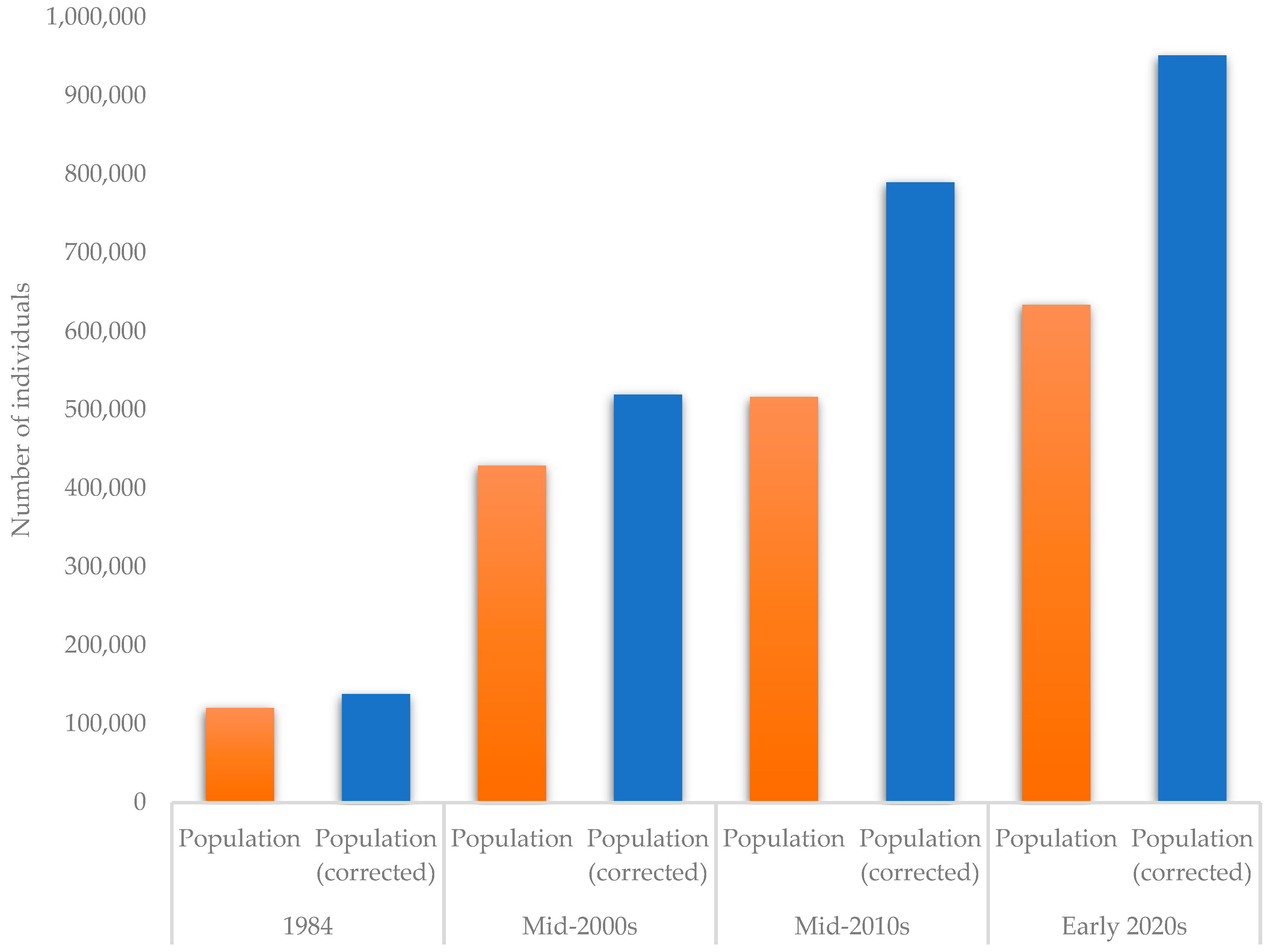
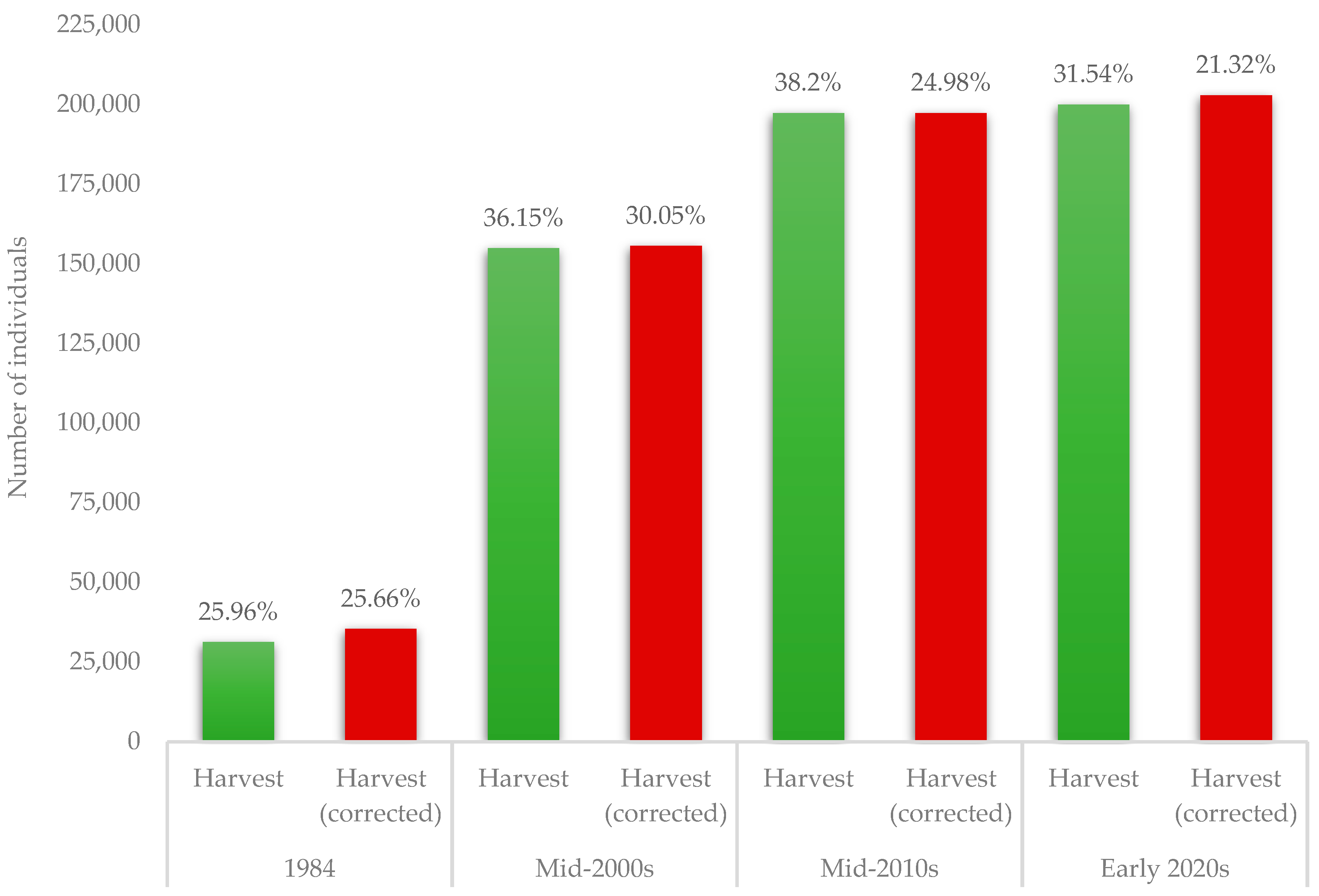

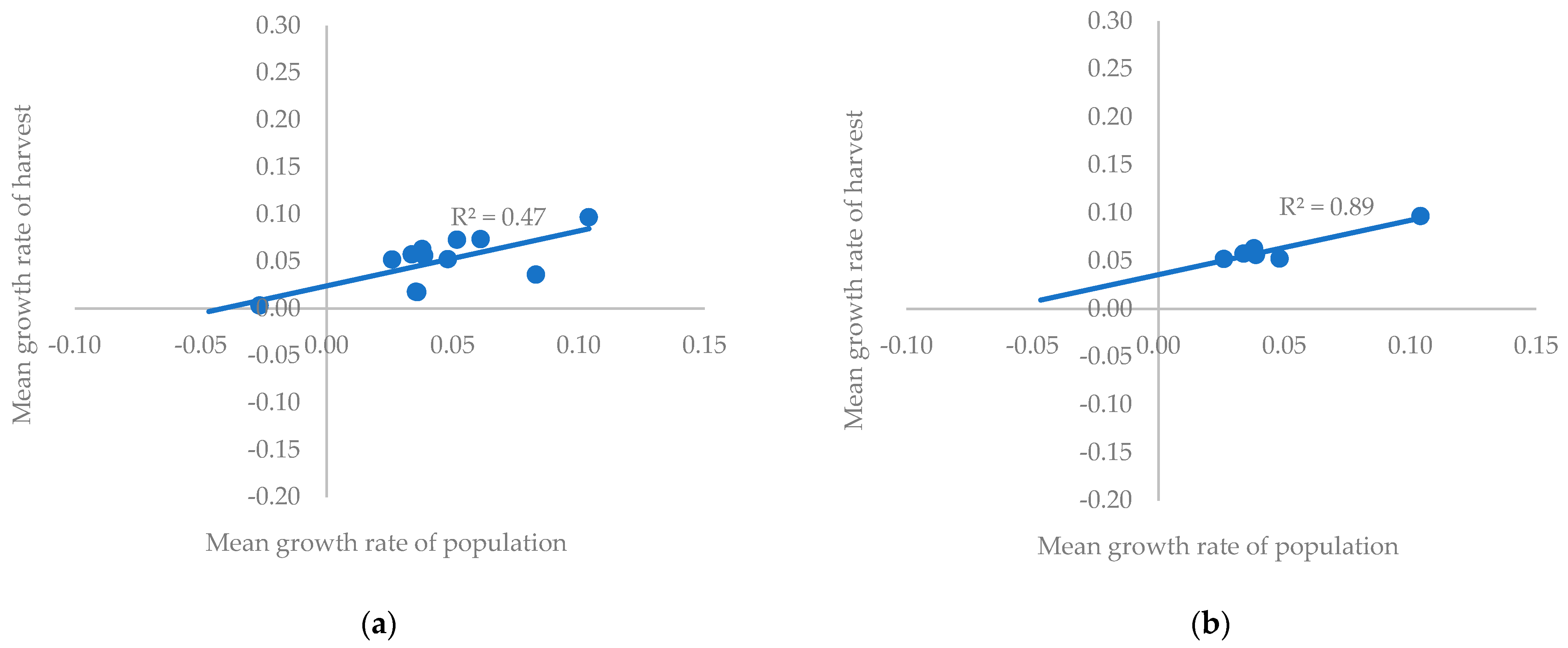
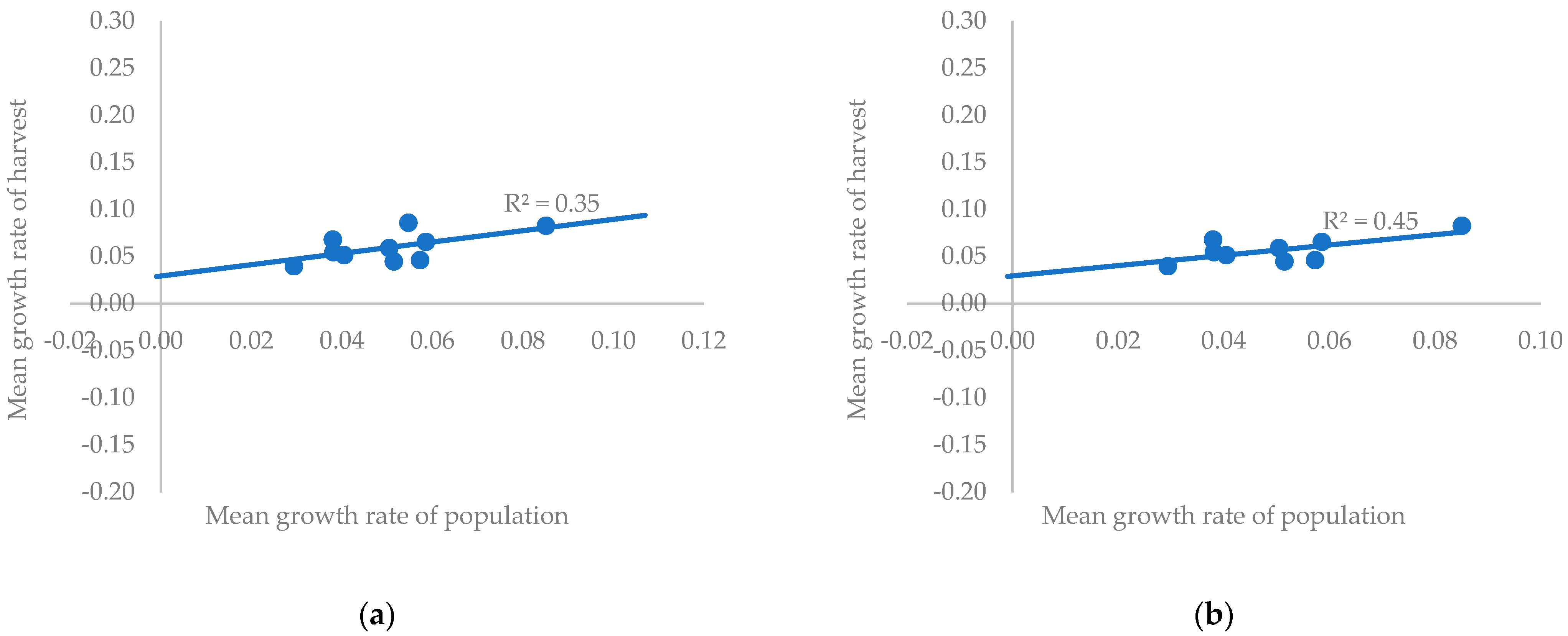
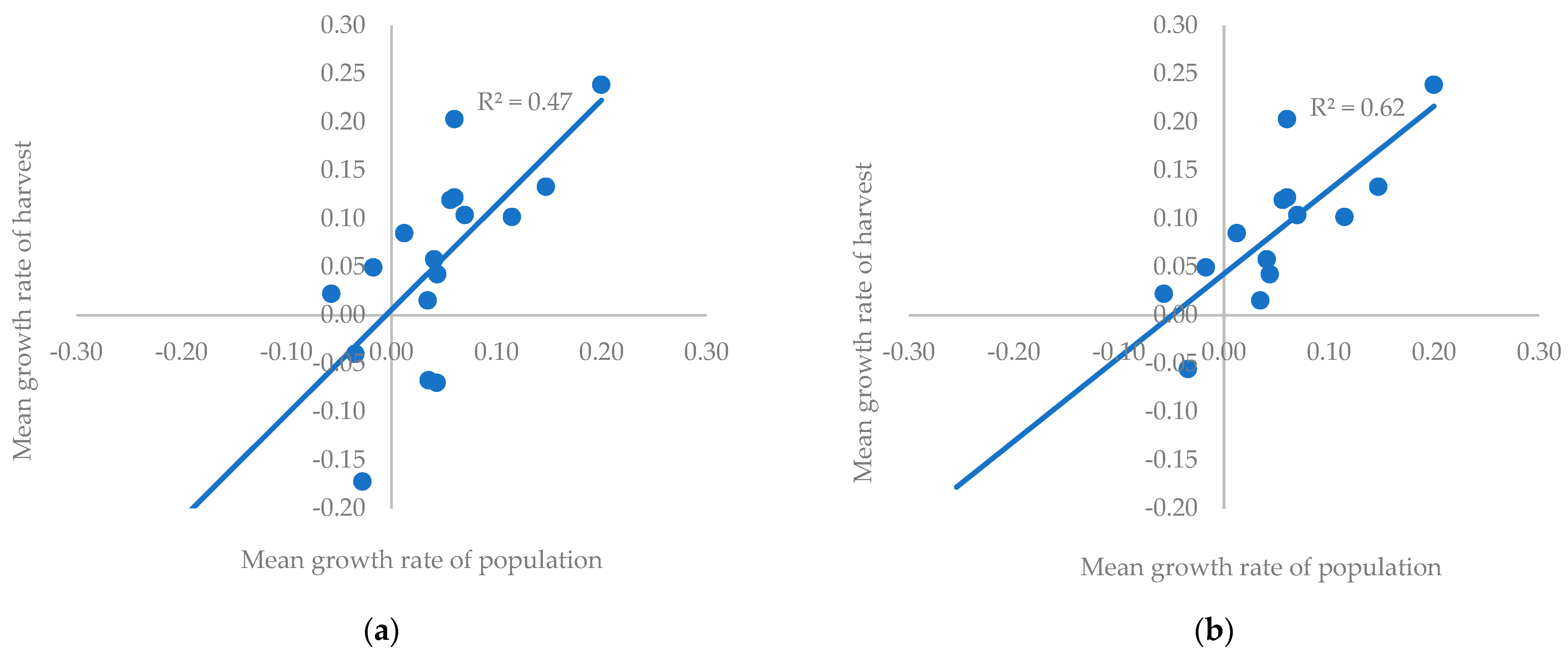
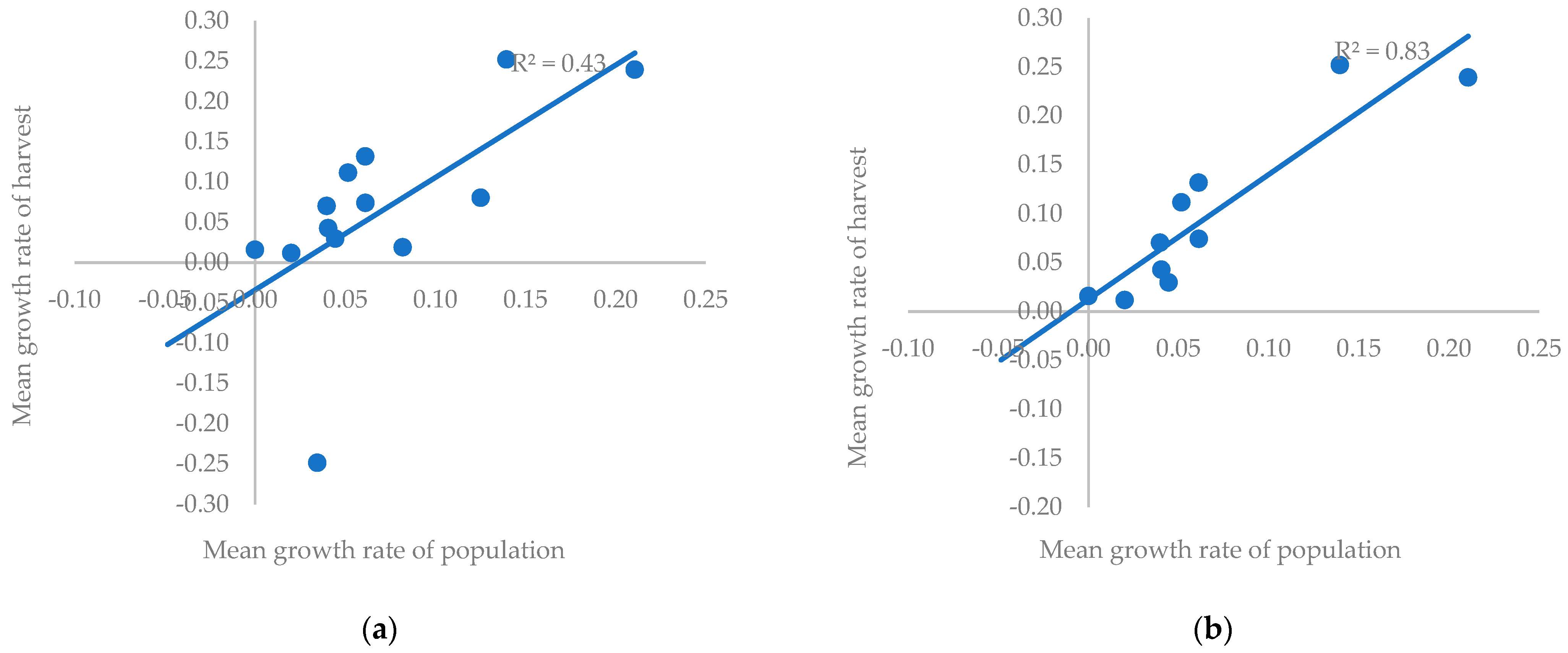
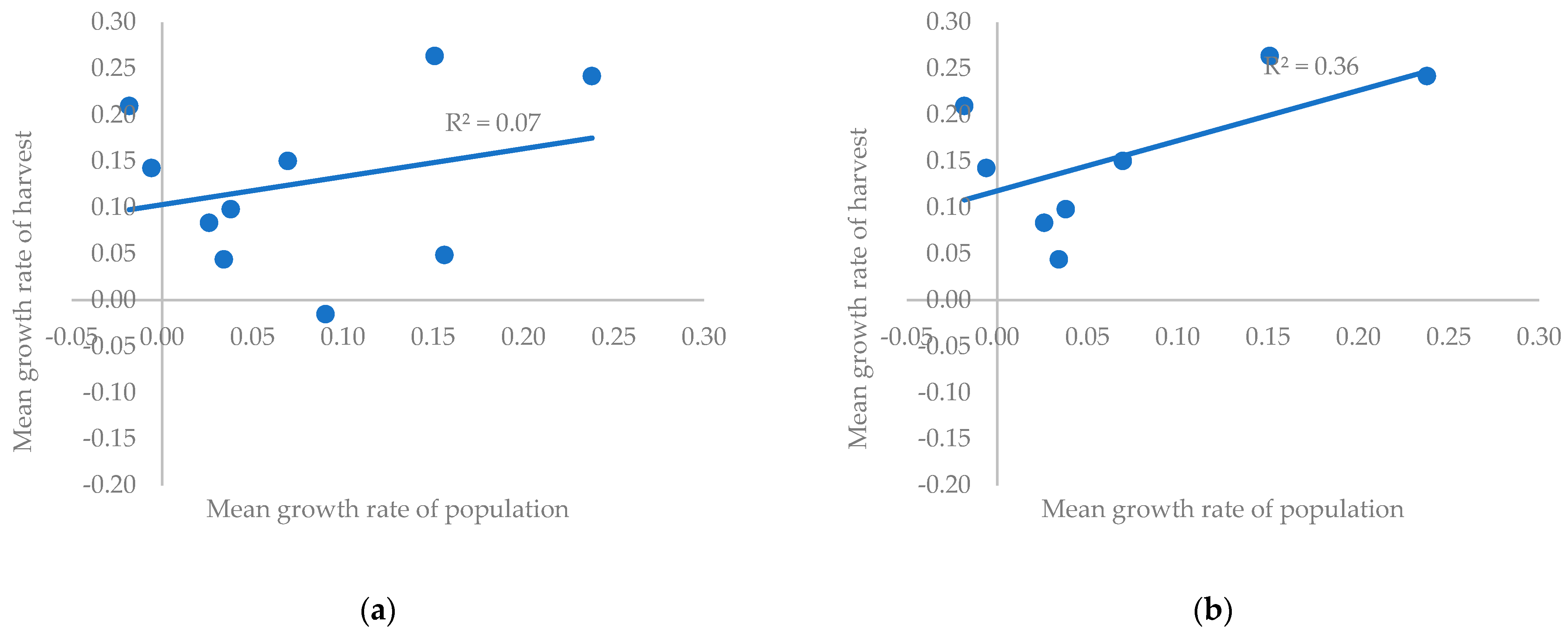
| Country | Data Source | Comments |
|---|---|---|
| Austria | Statistics Austria * | Only hunting bag; no estimations on wild populations |
| Belgium | INBO * | Only data from Wallonia from mid-2000s; only hunting bag data from Flanders for 2021 |
| Bulgaria | National Statistics Institute [18,19]; Stoyanov & Stoyanova [20] | No hunting bag data from 2020s |
| Croatia | Ministry of Agriculture | Data obtained from Croatian Hunting Association (pers. comm.) |
| Czech Republic | Czech Statistical Office * | N/A |
| Denmark | Aarhus Universitet (hunting bag) *; Aarhus Universitet (for population size 2010s) [21]; Danmarks Jaegerforbund (population size 2020s) [22] | N/A |
| Finland | National Resources Institute Finland * | Only hunting bag; pers. comm. for population estimations |
| France | ONCFS (for 2000s and 2010s) [23]; Réseau Ongulés sauvages (for 2020s) [24] | N/A |
| Germany | Bayerischer Jagdverband e.V. (for 2000s and 2010s) [25]; Deutscher Bundestag (for 2020s) [26] | N/A |
| Greece | Mattila & Hadjigeorgiou (2010s) [27] | No data for 2020s; fallow deer only enclosures; hunting ban |
| Hungary | Országos Vadgazdálkodási Adattár [28,29,30] | N/A |
| Ireland | National Parks and Wildlife Service (for 2000s), pers. comm. | N/A |
| Italy | Carnevali et al. 2009 (for 2000s) [31]; ISPRA 2013 (for 2010s) [32] | N/A |
| Lithuania | Lithuanian State Forest Service [33,34,35] | N/A |
| Luxembourg | Le Gouvernement de Grand-Duché de Luxembourg (pers. comm. for 2000s); The Statistics Portal (LUSTAT) (for 2010s and 2020s) * | No population estimations |
| Macedonia | State Statistical Office of the Republic of Macedonia * | No data for mid-2000s |
| The Netherlands | Vereniging Wildbeheer Veluwe (for 2000s and 2010s) [36]; Faunabeheereenheid (for 2020s) [37] | Data for 2020s was collected per province |
| Poland | Central Statistical Office [38,39] | N/A |
| Portugal | ICNF Divisão Recursos Cinegéticos e Aquicolas (pers. comm.) | N/A |
| Romania | National Institute of Statistics [40] | No data for 2020s |
| Serbia | Statistical Office of the Republic of Serbia (for 2019) [41]; Pers. comm. (for 2000s and 2010s) | N/A |
| Slovakia | National Forestry Center Zvolen (for 2020s) *; Pers. comm. (for 2000s and 2010s) | N/A |
| Slovenia | Slovenia Forest Service (for 2010s and 2020s) [42,43]; Pers. comm. (for 2000s) | No recent population estimations available, only for 1995 |
| Spain | Ministry of Agriculture, Fisheries and Food [44,45,46] | No recent population estimations available, only for 2000s |
| Sweden | Danell & Bergström, 2010 (for population estimation for 2000s) [47]; Viltdata (for hunting bags) * | No population estimation for early 2020s |
| Ukraine | State Statistics Service of Ukraine [48,49,50] | N/A |
| United Kingdom | NatureScot [51]; Mammal Society (for size for 2020s) [52] | Hunting bag for 2010s and 2020s from Scotland only |
| Time Period | Mean Growth Factor | R2 * | p-Value | N | ||
|---|---|---|---|---|---|---|
| Population (x) | Harvest (y) | Population (x) | Harvest (y) | |||
| 1984–2000s | 9.32 | 3.82 | 0.68 | 0.0006 | 20 | 13 |
| 1984–2010s | 5.89 | 7.71 | 0.58 | 0.0025 | 18 | 16 |
| 1984–2020s | 9.27 | 10.85 | 0.36 | 0.0113 | 13 | 14 |
| 2000s–2010s | 1.97 | 3.48 | 0.21 | 0.0655 | 20 | 23 |
| 2000s–2020s | 3.97 | 5.52 | 0.85 | 0.0000 | 15 | 19 |
| 2010s–2020s | 1.51 | 1.49 | 0.06 | 0.4893 | 13 | 19 |
Publisher’s Note: MDPI stays neutral with regard to jurisdictional claims in published maps and institutional affiliations. |
© 2022 by the authors. Licensee MDPI, Basel, Switzerland. This article is an open access article distributed under the terms and conditions of the Creative Commons Attribution (CC BY) license (https://creativecommons.org/licenses/by/4.0/).
Share and Cite
Bijl, H.; Csányi, S. Fallow Deer (Dama dama) Population and Harvest Changes in Europe since the Early 1980s. Sustainability 2022, 14, 12198. https://doi.org/10.3390/su141912198
Bijl H, Csányi S. Fallow Deer (Dama dama) Population and Harvest Changes in Europe since the Early 1980s. Sustainability. 2022; 14(19):12198. https://doi.org/10.3390/su141912198
Chicago/Turabian StyleBijl, Hanna, and Sándor Csányi. 2022. "Fallow Deer (Dama dama) Population and Harvest Changes in Europe since the Early 1980s" Sustainability 14, no. 19: 12198. https://doi.org/10.3390/su141912198
APA StyleBijl, H., & Csányi, S. (2022). Fallow Deer (Dama dama) Population and Harvest Changes in Europe since the Early 1980s. Sustainability, 14(19), 12198. https://doi.org/10.3390/su141912198







